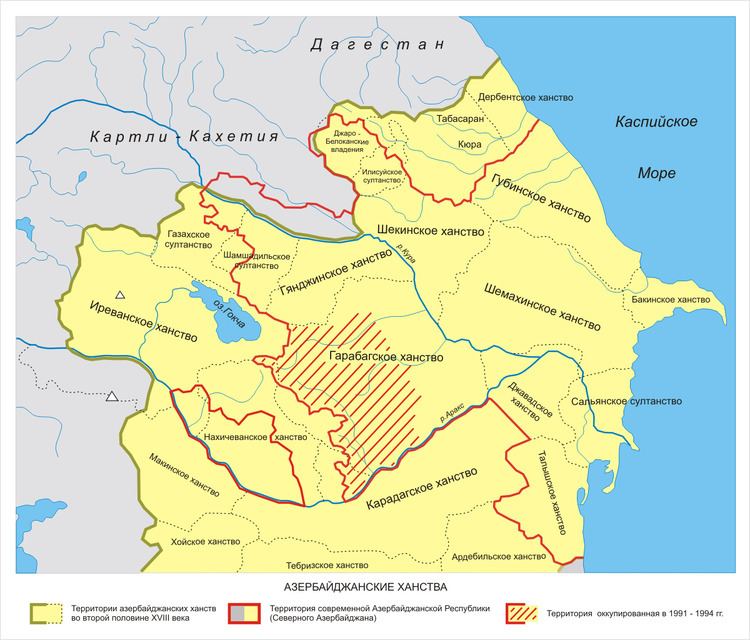 | ||
Western Azerbaijan (Azerbaijani: Qərbi Azərbaycan) is an irredentist political concept that is used in the Republic of Azerbaijan mostly to refer to the territory of the Republic of Armenia. Azerbaijani statements claim that the territory of the modern Armenian republic were lands that once belonged to Azerbaijanis. Its claims are primarily hinged over the contention that the current Armenian territory was under the rule of various Turkic tribes, empires and khanates from the late medieval period until the Treaty of Turkmenchay signed after the Russo-Persian War, 1826-1828. The concept has received official sanction by the government of Azerbaijan, and has been used by its current president, Ilham Aliyev, who has repeatedly stated that the territory of Armenia is a part of "ancient Turk and Azerbaijani land."
Contents
History
The present-day territory of Armenia and the western part of Azerbaijan is historically known as Armenian Highland.
Prior to the Caucasian khanates (in some sources referred to as the northern Azerbaijani khanates), the Oghuz Turkic tribal federations such as the Kara Koyunlu and Ak Koyunlu held sway in the region. Afterward the area was under the control of the Safavid Empire.
From the 17th-19th centuries, the area was administered by the Khans of the Qajar tribes which were of Turkic origin, under the Safavids, Afsharids, and Qajar Iranians, while Armenians had autonomy under the immediate jurisdiction of the melik of Erevan. Later on in 1828, the administrative khanate was dissolved and became a part of the Russian Empire as an outcome of the Treaty of Turkmenchay.
Demographic basis
From 1795 to 1804 during the clashes between the Russian and Persian Empire Armenians were taken as captives to Iran. There were also 20,000 Armenians who moved to Georgia. The Armenian-American historian George Bournoutian gives a summary of the ethnic makeup after those events:
After the incorporation of the Erivan khanate into the Russian Empire, Muslim majority of the area gradually changed, at first the Armenians who were left captive were encouraged to return. As a result of which an estimated 57,000 Armenian refugees from Persia returned to the territory of the Erivan khanates after 1828, while about 35,000 Muslims (Persians, Turkic groups, Kurds, Lezgis, etc.) out of a total population of over 100,000 left the region. Russia also had some anti-Armenian policies which included their removal.:
Migrations, albeit on a lesser scale, continued until the end of the 19th century. While the territory of Erivan khanate had a notable Muslim majority since the Armenian population was brought to Iran and left captive during the clash against the Russian Empire, the situation had been reversed under Russian rule by 1832.
At the beginning of the 20th century, there were 149 Azerbaijani, 91 Kurdish and 81 Armenian villages in Zangezur.
According to the Russian census of 1897, a significant population of Azeris still lived in Russian Armenia. They numbered about 300,000 persons or 37.8% in Russia's Erivan Governorate (roughly corresponding to most of present-day central Armenia, the Iğdır Province of Turkey, and Azerbaijan's Nakhichevan exclave, but excluding Zangezur and most of northern Armenia). Most lived in rural areas and were engaged in farming and carpet-weaving. They formed the majority in 4 of the governorate's 7 districts (including Igdir and Nakhichevan, which are not part of Armenia today and Sharur-Daralagyoz district which is mostly in Azerbaijan) and were nearly as many as the Armenians in Yerevan (42.6% against 43.2%). At the time, Eastern Armenian cultural life was centered more around the holy city of Echmiadzin, seat of the Armenian Apostolic Church. Traveller Luigi Villari reported in 1905 that in Erivan the Azeris (to whom he referred as Tartars) were generally wealthier than the Armenians, and owned nearly all of the land.
Some Azeri sources claim that currently there is not a single Azerbaijani in Armenia.
